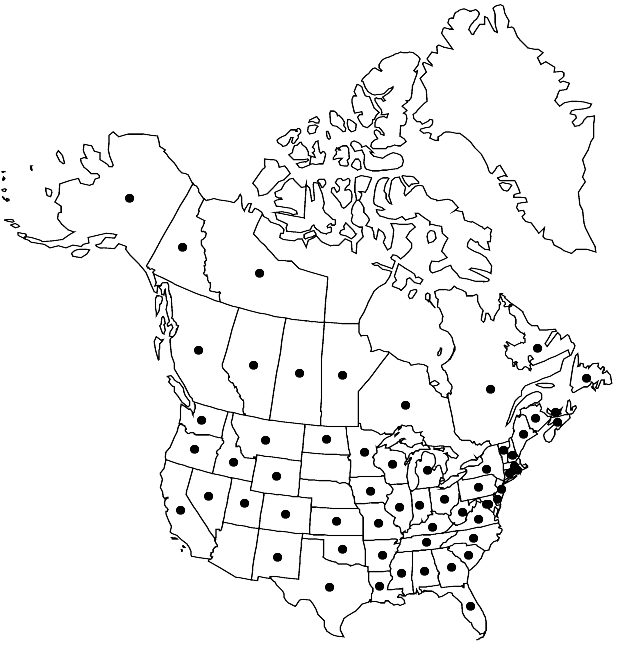Difference between revisions of "Cardamine pensylvanica"
Sp. Pl. 3: 486. 1801.
FNA>Volume Importer |
FNA>Volume Importer |
||
| Line 71: | Line 71: | ||
|publication year=1801 | |publication year=1801 | ||
|special status= | |special status= | ||
| − | |source xml=https://jpend@bitbucket.org/aafc-mbb/fna-data-curation.git/src/ | + | |source xml=https://jpend@bitbucket.org/aafc-mbb/fna-data-curation.git/src/f6b125a955440c0872999024f038d74684f65921/coarse_grained_fna_xml/V7/V7_743.xml |
|tribe=Brassicaceae tribe Cardamineae | |tribe=Brassicaceae tribe Cardamineae | ||
|genus=Cardamine | |genus=Cardamine | ||
Revision as of 20:23, 24 September 2019
Annuals or biennials; sparsely hirsute basally, glabrous distally. Rhizomes absent. Stems (simple from base), erect, (not flexuous), unbranched or branched distally, (0.5–)1.5–5.5(–7) dm. Basal leaves (soon withered), not rosulate, similar to proximalmost cauline leaves, 4–15 cm. Cauline leaves (3–)5–20(–35), pinnately (5 or) 7–13(–19)-foliolate, sometimes appearing pinnatisect, lobe number similar to leaflets (middle and proximal ones 2–11 cm), petiolate, leaflets petiolulate, subsessile, or sessile; petiole (0.4–)1–3.5(–4.5) cm, base not auriculate, (often sparsely hirsute); lateral leaflets shortly petiolulate or sessile, (decurrent on rachis smaller than terminal, distalmost blades narrower, with fewer lobes or leaflets), margins entire or crenate; terminal leaflet (subsessile or petiolule to 1 cm), blade suborbicular, obovate to oblanceolate, or elliptic, 1.3–3(–4) cm × 6–25 mm, base often cuneate, margins entire, repand, or obscurely 3 or 5-lobed. Racemes ebracteate. Fruiting pedicels divaricate-ascending, (3–)4–10(–13) mm. Flowers: sepals oblong, (1–)1.3–2.3 × 0.5–1 mm, lateral pair not saccate basally; petals white, narrowly spatulate to oblanceolate, 2–3.5(–4) × 0.8–1.5 mm, (not clawed); filaments: median pairs 1.5–2.5 mm, lateral pair 1–2 mm; anthers ovate, 0.2–0.3 mm. Fruits linear, (torulose), (1.4–)1.7–2.7(–3.2) cm × 0.8–1.1 mm; ovules 40–80 per ovary; style 0.5–1 mm. Seeds brown, oblong to ovoid, 0.7–1.1 × 0.5–0.8 mm. 2n = 32, 64.
Phenology: Flowering Apr–Jul.
Habitat: Marshes, streams, swamps, ditches, seepage, springs, lake margins, mesic bottomland and upland forests, wet areas, ledges of sheltered bluffs, banks and shallow water of streams and spring branches, margins of crop fields, waste ground
Elevation: 0-2800 m
Distribution

Alta., B.C., Man., N.B., Nfld. and Labr., N.W.T., N.S., Ont., P.E.I., Que., Sask., Yukon, Ala., Alaska, Ark., Calif., Colo., Conn., Del., D.C., Fla., Ga., Idaho, Ill., Ind., Iowa, Kans., Ky., La., Maine, Md., Mass., Mich., Minn., Miss., Mo., Mont., Nev., N.H., N.J., N.Mex., N.Y., N.C., N.Dak., Ohio, Okla., Oreg., Pa., R.I., S.C., Tenn., Tex., Utah, Vt., Va., Wash., W.Va., Wis., Wyo.
Discussion
We have not seen material of Cardamine pensylvanica from Nebraska or South Dakota; it is very likely that the species grows in these states as well.
Selected References
None.